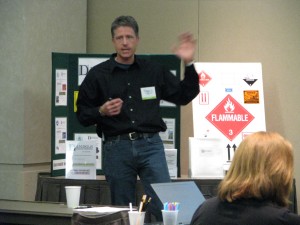Federal regulations of the U.S. Environmental Protection Agency (USEPA) mandate a small quantity generator of hazardous waste (SQG) take certain precautions to prepare for and prevent hazardous waste emergencies and to follow emergency procedures if one were to occur. These regulations are found within the SQG conditions of exemption at 40 CFR 262.16:
- 40 CFR 262.16(b)(8) Preparedness and prevention
- 40 CFR 262.16(b)(9) Emergency procedures
This article is the third in a series that closely examines these regulations and attempts to make them understandable.
The previous article in this series addressed 40 CFR 262.16(b)(8)(ii) Required equipment
The purpose of this article is to address the requirements of 40 CFR 262.16(b)(8)(iii) Testing and maintenance of equipment.
Before we begin…
These regulations were revised by the Generator Improvements Rule. If your state has not yet adopted the new rule you must continue to comply with the earlier version until it does. You may read an article explaining the earlier version of the regulations (prior to implementation of the Generator Improvements Rule) here.

Scope and Applicability:
These regulations are applicable to a SQG. The requirements of a large quantity generator of hazardous waste (LQG) are almost exactly the same. If you are a LQG please refer to this article for your version of these regulations: Emergency Preparedness and Prevention for Large Quantity Generator: Testing and Maintenance of Equipment.
|
Not sure of your hazardous waste generator status? |
As explained in an earlier article of this series, these regulations solely apply to those areas of a SQG where hazardous waste is:
- Generated, i.e., the point of generation.
- Accumulated, i.e., central accumulation area and satellite accumulation area.
- Areas where allowable treatment takes place
- Areas where hazardous wastes are stored prior to off site transportation.
40 CFR 262.16(b)(8)(iii) reads:
(iii) Testing and maintenance of equipment. All communications or alarm systems, fire protection equipment, spill control equipment, and decontamination equipment, where required, must be tested and maintained as necessary to assure its proper operation in time of emergency.
What changed?
No change, really. Just the removal of the word “facility” between “All” and “communications” in the opening sentence. This clarifies the applicability of the regulations (discussed in an earlier article: 40 CFR 262.16(b)(8)(i) Maintenance and Operation of Facility) to the areas of a SQG where hazardous waste is generated or accumulated but not necessarily the entire facility.
|
Contact me with any questions you may have about the generation, identification, management, and disposal of hazardous waste Daniels Training Services, Inc. 815.821.1550 |
Let’s take a closer look at the wording, terms, and phrases used in §262.16(b)(8)(iii):
All communications or alarm systems,…” The items listed here are the same as those identified as “required equipment” in an earlier section: §262.16(b)(8)(ii) Required equipment. They are:
- Communications or alarm systems (both internal and external).
- Fire protection equipment (including special extinguishing equipment).
- Spill control equipment.
- Decontamination equipment
“…where required…” As noted in the Scope and Applicability section of this article, not all areas of a SQG are required to have emergency response equipment. And even in those areas, a SQG may determine for safety reasons that the placement of emergency equipment is not feasible or practical and therefore choose another area. For a more thorough description of the SQG’s responsibility to place its emergency equipment read The Requirements of 40 CFR 262.16(b)(8)(ii) Required Equipment for Preparedness, Prevention, and Emergency Procedures at Small Quantity Generator of Hazardous Waste.
|
Daniels Training Services, Inc. 815.821.1550 |
“…must be tested and maintained…” This section requires the testing and maintenance of the required equipment. Note the following:
- The type and frequency of testing and maintenance is intentionally not defined by the USEPA, “…tested and maintained as necessary…”. This is due to the variety of systems and equipment encompassed by these regulations (communication, alarm, fire, spill control, etc.). It is up to the SQG to determine compliance based on guidance from the equipment manufacturer, industry standards, insurance provider, Fire Marshall, and if applicable, OSHA standards.
- The regulations do not require the SQG to keep a record for a specified period of time to demonstrate compliance as it does for other RCRA Regulations (Read: Recordkeeping Requirements of RCRA). It is recommended to maintain some form of a record and make it available upon inspection if necessary.
- I have noticed in industry the slow erosion of spill control and decontamination equipment as it is consumed for routine spills and housekeeping. A SQG should communicate and enforce policies to ensure emergency equipment is used only in emergencies. Other resources should be made available to employees for non-emergency clean-ups. In addition, routine inspections (perhaps weekly with your inspection of hazardous waste accumulation areas) is a good way to ensure necessary emergency equipment is available.
Is that it?
No. There are still the remainder of the emergency preparedness and prevention regulations for a SQG in §262.16(b)(8). Also, there are the SQG emergency procedures of §262.16(b)(9). And, right in the midst of the SQG emergency procedure regulations is where we will find the training requirements for a SQG at §262.16(b)(9)(iii).
|
Contact me the next time hazardous waste generator USEPA training is due to expire. |
The next article in this series: 40 CFR 262.16(b)(8)(iv) Access to communications or alarms systems

